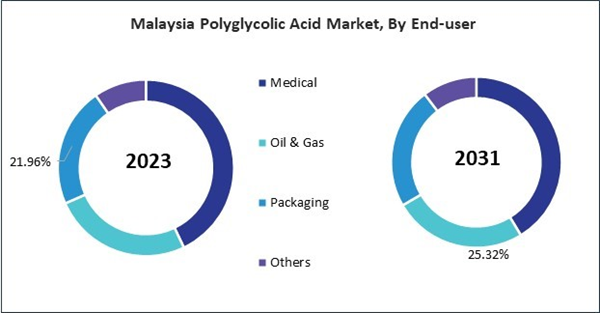The Oil & Gas end-user industry is increasingly exploring the potential of Polyglycolic Acid (PGA) in various applications, driven by its unique properties and environmental advantages. PGA's high strength, chemical resistance, and biodegradability make it a promising material for several key areas within the industry. Thus, the China market would utilize 1,806.6 tonnes of Polyglycolic Acid in Oil & Gas end-user industry by 2031.
The China market dominated the Asia Pacific Polyglycolic Acid Market by Country in 2023, and would continue to be a dominant market till 2031; thereby, achieving a market value of $711.9 million by 2031. The Japan market is registering a CAGR of 9.8% during (2024 - 2031). Additionally, The India market would capture a CAGR of 11.2% during (2024 - 2031).
The rising healthcare sector in this region has played a significant role in expanding the demand for polyglycolic acid (PGA) due to its diverse applications in medical devices, surgical procedures, and drug delivery systems. As per the data from the Government of Australia, In 2021-22, the nation reportedly spent $241.3 billion on health products and services, or roughly $9,365 per person on average. Inflation-adjusted real growth in total health expenditures (recurrent and capital) was 6.0% higher than in 2020-21.
Furthermore, polyglycolic acid's utility extends to agricultural applications, producing biodegradable mulch films, soil stabilization mats, and crop protection nets. These agricultural applications leverage PGA's biodegradability to reduce plastic waste in farming practices while providing effective soil erosion control and crop protection solutions. PGA-based crop protection nets safeguard crops from pests, birds, and adverse weather conditions while allowing air, light, and moisture to penetrate. These nets provide a physical barrier to protect crops without the need for chemical pesticides or harmful synthetic materials.
Australia has a growing awareness of environmental issues, particularly plastic pollution and waste management. Consumers increasingly seek eco-friendly alternatives to traditional plastic packaging, driving demand for biodegradable and compostable materials like PGA. The packaging industry in Australia is responding to this demand by exploring sustainable packaging solutions that minimize environmental impact.
As per the Government of Australia, in 2018, Australia established the ambitious 2025 National Packaging Targets. One of the targets was to achieve 100% of packaging being reusable, recyclable, or compostable by 2025. Hence, the growing packaging and agriculture sector in the Asia Pacific will pose lucrative growth prospects for the regional polyglycolic acid market.
Based on Form, the market is segmented into Fibers, Films and Others. Based on End User, the market is segmented into Medical, Oil & Gas, Packaging, and Others. Based on countries, the market is segmented into China, Japan, India, South Korea, Singapore, Malaysia, and Rest of Asia Pacific.
List of Key Companies Profiled
- BMG Incorporated
- Huizhou Foryou Medical Devices Co., Ltd. (GL Capital Group)
- Unisur Lifecare Pvt Ltd
- Orion Sutures India Pvt Ltd
- Kureha Corporation
- Shenzhen Polymtek Biomaterial Co., Ltd
- Haihang Industry Co., Ltd. (Haihang Group)
- Polysciences, Inc.
- Teleflex Incorporated
- Merck KGaA
Market Report Segmentation
By Form (Volume, Tonnes, USD Billion, 2020-2031)- Fibers
- Films
- Others
- Medical
- Oil & Gas
- Packaging
- Others
- China
- Japan
- India
- South Korea
- Singapore
- Malaysia
- Rest of Asia Pacific
Table of Contents
Companies Mentioned
- BMG Incorporated
- Huizhou Foryou Medical Devices Co., Ltd. (GL Capital Group)
- Unisur Lifecare Pvt Ltd
- Orion Sutures India Pvt Ltd
- Kureha Corporation
- Shenzhen Polymtek Biomaterial Co., Ltd
- Haihang Industry Co., Ltd. (Haihang Group)
- Polysciences, Inc.
- Teleflex Incorporated
- Merck KGaA
Methodology

LOADING...









